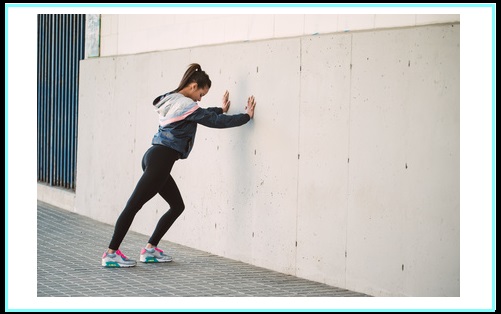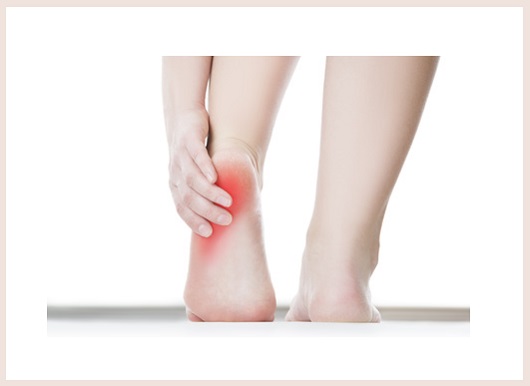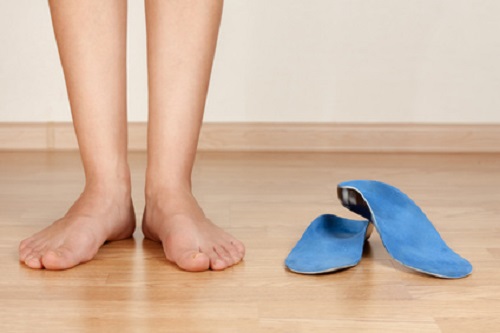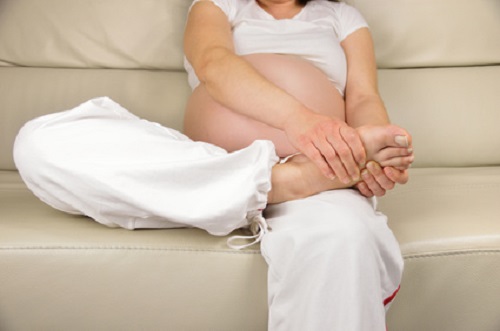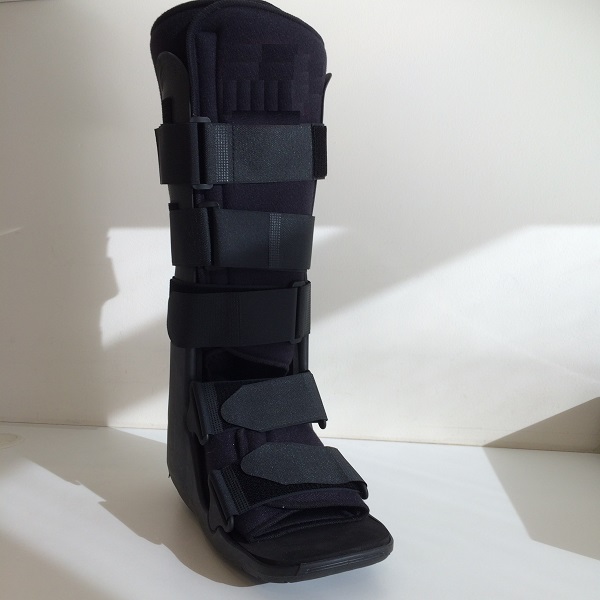Do stretches help plantar fasciitis pain?
Every person who has ever hobbled into my clinic with plantar fascia foot pain has one goal in mind. They want their pain to STOP, and they want it to stop NOW! I can certainly help with the STOP part of their goal. The NOW part of their goal takes more time and effort. I wish I had a NOW magic wand, however consistent, long-term, and safe success is often achieved with a simple formula where I ask people to do stretches to help plantar fascia pain.
9 Stretches to help with plantar fasciitis recovery
Stretches and exercises for plantar fasciitis are varied and can help tremendously and may even eliminate the need for surgery, steroid injection or othotics. You will quickly notice that these stretches don’t directly target where your plantar fascia pain is. Relax. I will explain a bit more about this later.
Here is the good news – you don’t need to do all 9 stretches, but instead test and review. Remember – no magic wand. Here are my top 7 stretches for plantar fascia pain:
- Stand on Magazines Stretch
- Toe Stretch 1
- Toe Stretch
- Hands-on Wall Calf Stretch
- Towel Calf Stretch
- Toes to the wall Knee bend
- Tennis Ball Fascia Stretch
- Frozen Plastic Bottle Stretch
- The Knuckle
1. Stand on Magazine Stretch

Place a magazine or thin book on the floor. With your heel on the ground, place the ball of your foot on the magazine and stand up straight. What can you feel? Can you stand up straight, tucking your bottom in? Can you feel any pain in the back of your calf?
If you can’t stand up straight or have calf pain, you definitely will benefit from these stretches – BUT – slow down, we need to back off and be a bit more gradual. Reduce the thickness of the magazine and try again. You may only be able to stand on 10 pages. Don’t worry, you are not the first person who thought this sounded easy until they tried it.
So here is the plan – Stand on your starting thickness of the magazine for 2 minutes, four times a day. When it starts to feel easier, then increase the thickness bit by bit. The goal is to be standing on a 4-inch (100mm) stack of magazines. This may take 6 weeks. The secret is gradual, slow and steady. Speedy, macho, punch through the pain methods usually end in tears. Slow and Steady.
2. Toe Stretch with Help
If you have someone to help you, the toe stretch is best done with leg straight, rather than with knee bent. If it is only you, then just do the best you can.
Hold the foot firmly but gently across the metatarsals with one hand. Using the other hand, gently and slowly press the toes downwards and upwards.
3. Toe Stretch with No Help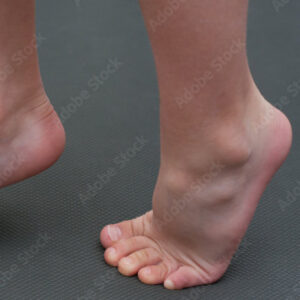
If you have no one to help you, the Toe Stretch has another version Sit down with both feet on the floor. You then raise your heel, so that only the ball on your foot is in contact with the floor
A variation of the sitting toe stretch is to stand with both feet on the floor. You then raise both heels, so that only the balls of the feet are in contact with the floor.
Once again – go easy – be kind to your feet and legs – gently is key.
4. Hands on a Wall Calf Stretch
This is a very well-known stretch. Stand about 12 inches (30 cm) from and facing a wall. Place your hands on the wall. Bend your left knee, move your right foot back, keeping your knee straight and heel on the ground (see picture). Hold the position.
You may feel a stretching feeling in your calf (back of your leg) and hamstring (back of your thigh). Start by standing closer to the wall, and then as the weeks go by, move further from the wall. Swap legs.
Extra Tip: If you have an underlying back problem this stretch is probably not for you.
5. Towel or Band Calf Stretch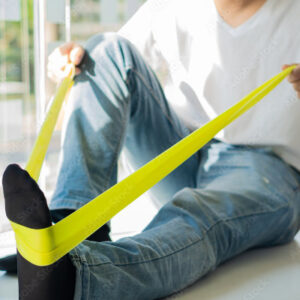
This stretch can be done lying down or sitting with legs straight.
Keeping hold of each end of a bath towel or elastic band, throw the towel under the bottom of the ball of your foot. Gently pull the towel towards you, keeping your knee straight.
You may feel the gentle pull of the muscles in the back of your legs – this is the stretch.
You can do one leg at a time or both. It is up to you.
6. Toes to the wall Knee bend

This stretch is generally advised for people who have very bulky, muscular calf muscles.
Stand facing a wall with your toes almost touching the wall. Keeping a straight back and your heels on the ground, bend your knees and touch the wall with your knee and hold for 1 minute.
Does that sound easy enough?
Then, stand up straight again, move your feet one inch (2.5 cm) from the wall and bend your knees. Can you still touch the wall with your knees? If yes – move another inch away from the wall
Repeat 4 times a day until you are standing at least 4 inches (100 cm) from the wall and holding the knee bent position for 2 minutes. Remember – gradual and gentle.
7. Tennis Ball Fascia Stretch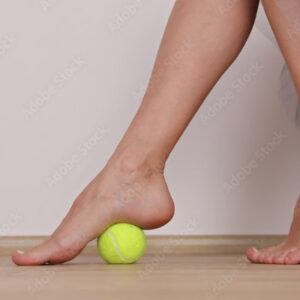
This stretch may be considered more of a massage than a stretch.
Take off your shoes. Sit or stand, whichever is more convenient and place the tennis ball under the arch of the foot. Roll your foot backwards and forwards over the tennis ball.
If there are any areas that are particularly sore to touch, go gently. Too much pressure or body weight can cause further damage to the soft tissue structures on the bottom of your foot. Repeat regularly during the day.
Some people advocate using a prickly ball for this stretch. For older people or people with bad circulation to the feet, the prickly ball may damage the skin or the natural fatty padding under the skin. As always – go gently.
8. Bottle Stretch
The bottle stretch is very similar to the tennis ball stretch but you use a plastic drink bottle with water. I find that a 1 pint (600ml) water bottle is a really nice size for under the arch of the foot.
Simply roll the filled bottle backwards and forwards. Start with 30 seconds and build up to 4 minutes over a period of weeks.
A common variation of the water bottle stretch is to use a bottle of frozen water. This may be particularly helpful if your plantar fascia pain is worse after you have been exercising.
9. The Knuckle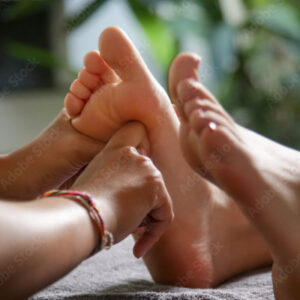
The following approach is more of an Osteopathic method. Running your knuckle back and forth along the length of your plantar fascia may help to free up the fibres and move any interstitial fluid within the plantar fascia. Go gently.
What is Plantar Fasciitis?
When it comes to foot pain, there are fewer types more painful than the kind caused by the dreadful condition known as plantar fasciitis. This condition comes about when the plantar fascia, which is the ligament that runs along the bottom of your feet, becomes inflamed, irritated, or strained. Once this ligament has been injured in some way, it often becomes weak and swollen, which makes it incredibly difficult and painful to walk on.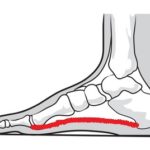
Plantar fasciitis is most often dealt with by athletes, due to all the hard foot planting they do and the stress they put on their plantar fascias, but it can happen to anybody. The most common causes of plantar fasciitis include;
- Rolling the feet inward when you walk, otherwise known as excessive pronation
- Being born with either flat feet or high arches
- Standing, running or walking for very long periods of time on hard surfaces
- Being overweight
- Wearing worn-out shoes or shoes that don’t fit well
- Having a tight Achilles tendon or tight calf muscles
What are the Symptoms?
For most of the people who have suffered or are suffering from the condition, the symptoms are noticeable almost immediately as they roll out of bed to take their first step of the day. The pain is in the bottom side of the foot generally, and hurts most during the first few steps of the day, or the first few steps after sitting for a prolonged period of time. Climbing stairs and standing for long periods of time are the two activities that are reported to cause the most pain to those suffering from plantar fasciitis.
How is it treated?
This is no single agreed upon treatment for every single patient with plantar fasciitis, but there are a variety of different angles from which a sufferer of plantar fasciitis can attack the problem.
- Resting the feet is the most commonly prescribed method of treatment and is the only thing that all patients need to do as much as possible. The ligament underneath the foot cannot heal properly unless it’s given adequate time to rest and repair itself. Using a camboot for immobilization is generally not required
- Icing the heel and taking anti-inflammatory medication can help reduce swelling and pain, albeit temporarily.
- Stretches can help immensely; we will covered these previously.
- Getting new shoes that fit properly and support the arch can help with the healing process, as well as prevent future bouts of plantar fasciitis from occurring.
By using one of these treatments or a combination of them, you should see some relief within a few weeks, but it can take up to a year for this condition to heal if you aren’t getting the proper rest.
In Conclusion
Plantar fasciitis is a very painful condition that affects many people who are on their feet for long periods of time, as well as athletes at all levels. If you have plantar fasciitis, it’s important to do the best stretches and exercises outlined in this article, as well as make sure you have properly fitting shoes and give your feet plenty of rest. Rest is an important factor when it comes to healing plantar fasciitis, but gentle stretching may improve your recovery time. Make sure to take steps to ensure you don’t get plantar fasciitis again, as well.
Original article November 3, 2018
Updated June 30th 2023

